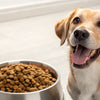Why is Dog Food Called Kibble? Understanding the Origins and Evolution of Kibble
- Houndsy
Table of Contents
- Introduction
- The Historical Roots of Kibble
- The Manufacturing Process of Kibble
- Kibble vs. Other Dog Food Options
- Our Commitment to Enhancing the Dog Feeding Experience
- Conclusion
Introduction
Have you ever paused to wonder why your dog eagerly wags their tail at the mere mention of “kibble”? This colorful, crunchy food has become synonymous with dog feeding and is a staple in countless households. In fact, recent statistics indicate that nearly 70% of dog owners in the U.S. feed their pets kibble as their primary source of nutrition. Yet, despite its widespread use, few of us truly understand the origins of this term or the history behind it.
In this blog post, we will delve into the fascinating journey of kibble, exploring why it’s called that, how it came to be, and the implications of feeding our dogs this type of food. By the end of this article, we hope to enhance your understanding of kibble and inspire you to reflect on your own pet feeding practices. We will also discuss how our flagship product, the Houndsy Kibble Dispenser, is designed to elevate the dog feeding experience, making it not only convenient but also visually appealing.
The Historical Roots of Kibble
The Early Days of Dog Feeding
Before the commercialization of dog food, our canine companions were primarily fed leftovers from the human diet. In ancient times, dogs scavenged for scraps from human meals, or they were fed what their owners deemed suitable. This included anything from table scraps to the remains of hunted animals. As the domestication of dogs progressed, their diets began to reflect a blend of human food and what could be foraged or hunted.
By the mid-19th century, as more families welcomed dogs into their homes and began to see them as family members, the need for tailored dog nutrition became clear. Owners wanted to provide their pets with the best possible diet, which led to the first commercial dog food products.
The Birth of Kibble
The modern concept of kibble can trace its roots back to the late 19th century when James Spratt, an American electrician living in England, created the first commercial dog food known as Spratt’s Dog Cakes. Inspired by sailors who fed their leftover hardtack biscuits to stray dogs, Spratt formulated a dry biscuit made from wheat, vegetables, and meat. This early version of kibble was a significant innovation, marking the transition from homemade dog food to a commercially produced option.
As the pet food industry grew, innovations continued. By the 1950s, the extrusion process was developed, allowing dog food manufacturers to produce kibble in various shapes and sizes. This method involves cooking a mixture of ingredients—such as meat meal, grains, and vegetables—under high pressure and temperature, which results in the dry pellets we recognize today.
The Meaning Behind the Name
So, why is dog food called kibble? The term “kibble” is believed to originate from the word “kibble,” which refers to small, rounded pieces of food or pellets. This nomenclature perfectly describes the shape and texture of the food that has become a staple in dog diets. Kibble is not only practical but also appealing—its crunchiness often delights our furry friends.
The Manufacturing Process of Kibble
Ingredients and Their Role
The composition of kibble has evolved significantly since its inception. Today, kibble typically includes a blend of high-quality meat, grains, vegetables, vitamins, and minerals. The quality of these ingredients is crucial, as they provide the essential nutrients that dogs need to thrive.
- Meat Meal: A concentrated source of protein, meat meal is made from rendered animal parts. It is vital for muscle development and overall health.
- Grains: Ingredients like rice or corn provide carbohydrates and energy.
- Vegetables: Carrots, peas, and other veggies add fiber and essential nutrients.
- Vitamins and Minerals: These supplements ensure a balanced diet, aiding in everything from bone health to immune function.
The Extrusion Process
The process of creating kibble involves several steps:
- Mixing: All ingredients are combined into a dough-like mixture.
- Cooking: The mixture is subjected to high heat and pressure in a process known as extrusion.
- Shaping: The cooked mixture is forced through a die-cutting machine, shaping it into the familiar kibble pellets.
- Drying: The kibble is dried to remove moisture, ensuring a long shelf life.
- Coating: Finally, a mixture of fats and flavorings is sprayed onto the kibble to enhance taste and palatability.
Nutritional Considerations
While kibble is convenient and easy to store, it’s important to be mindful of the quality of the product. Some kibbles may contain fillers, artificial preservatives, and low-quality meat by-products. As responsible pet owners, we must choose kibble that prioritizes high-quality ingredients to ensure our dogs receive the nutrition they need without harmful additives.
Kibble vs. Other Dog Food Options
The Rise of Alternatives
In recent years, there has been a growing awareness of pet nutrition, leading many owners to explore alternatives to traditional kibble. Options such as raw food diets, homemade meals, and freeze-dried options have gained popularity. Each of these alternatives offers unique benefits and challenges.
- Raw Diets: Advocates of raw feeding argue that this approach more closely mimics a dog’s natural diet, which is primarily composed of meat, bones, and organs. This diet is rich in nutrients but can be time-consuming and requires careful planning to ensure it is balanced.
- Homemade Meals: Preparing meals at home allows owners to control the ingredients and avoid fillers. However, it can be labor-intensive and requires knowledge of canine nutrition to ensure a balanced diet.
- Freeze-Dried Food: This option retains the nutritional value of raw ingredients while offering the convenience of kibble. It typically requires rehydration before serving, making it an attractive middle ground between kibble and raw diets.
The Kibble Convenience Factor
Despite the rise of alternatives, kibble remains the most popular choice among dog owners for several reasons:
- Convenience: Kibble is easy to measure, store, and serve. Its long shelf life and ability to be purchased in bulk make it a practical choice for busy pet parents.
- Cost-Effectiveness: Kibble is often more affordable than raw or fresh food options, making it accessible for a wider range of pet owners.
- Dental Health Benefits: The crunchiness of kibble can help reduce plaque and tartar buildup on dogs’ teeth, promoting better dental health.
Our Commitment to Enhancing the Dog Feeding Experience
At Houndsy, we believe that the feeding ritual should be a delightful experience for both dogs and their owners. That’s why we designed our flagship product, the Houndsy Kibble Dispenser.
Elevating the Feeding Ritual
The Houndsy Kibble Dispenser is more than just a storage solution; it's a beautifully crafted, ergonomic product that simplifies the daily feeding routine. Here’s how it works:
- Convenient Crank Mechanism: With a simple crank at standing height, we’ve eliminated the need for bending over to scoop food, making mealtime a pleasure.
- Perfect Portion Control: Our dispenser is designed to deliver the perfect portion every time, ensuring that your dog receives the right amount of food without waste.
- Beautiful Design: Combining mid-century modern aesthetics with functionality, the Houndsy Kibble Dispenser complements modern home decor while keeping your dog’s food fresh and accessible.
Quality and Reliability
We pride ourselves on using high-quality materials to create a reliable product. The large storage capacity of our dispenser, which accommodates 25–30 lbs of kibble, ensures that you have enough food on hand for your furry friend. The BPA-free liner keeps kibble fresh, while the auto-locking mechanism prevents accidental dispensing by curious pets or toddlers.
Investing in a Houndsy Kibble Dispenser means investing in a product that not only meets practical needs but also enhances the overall experience of feeding your dog.
Conclusion
As we’ve explored, the term “kibble” carries with it a rich history rooted in innovation and necessity. From its humble beginnings as leftover hardtack for dogs to the modern convenience of extruded kibble, this dog food staple has evolved significantly. Understanding this journey helps us appreciate not only the food we give our pets but also the importance of making informed choices about their nutrition.
As we continue to embrace the convenience of kibble, let us also remain vigilant about the quality of the food we choose. At Houndsy, we’re committed to enhancing the pet feeding experience through innovative design and functionality. Our Houndsy Kibble Dispenser is here to help you elevate this daily ritual, ensuring that feeding your dog is both convenient and enjoyable.
So, next time you reach for that bag of kibble, consider the journey it has taken to get there. Reflect on your own feeding routines and the choices you make for your furry family member. And if you're ready to experience the next level of dog feeding convenience, check out our Houndsy Kibble Dispenser here.
FAQ
What is kibble made of?
Kibble is typically made from a combination of meat meal, grains, vegetables, vitamins, and minerals. The quality of these ingredients can vary significantly between brands.
Why is kibble important for dogs?
Kibble provides a convenient, balanced source of nutrition for dogs. It is formulated to meet their dietary needs, ensuring they receive essential nutrients.
Can I feed my dog only kibble?
While kibble can be a complete diet, many veterinarians recommend varying your dog’s diet with fresh foods or alternative options to ensure a well-rounded nutritional intake.
How do I choose the right kibble for my dog?
Look for high-quality ingredients, avoid fillers and artificial additives, and consider your dog’s specific dietary needs. Consulting with your veterinarian can also help you make an informed decision.
How can the Houndsy Kibble Dispenser improve my dog feeding routine?
The Houndsy Kibble Dispenser offers ergonomic convenience, perfect portion control, and a beautiful design that enhances your home while keeping your dog’s kibble fresh and accessible.












